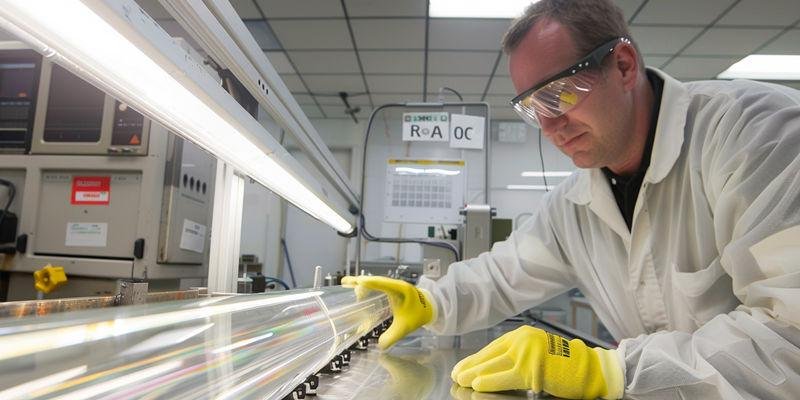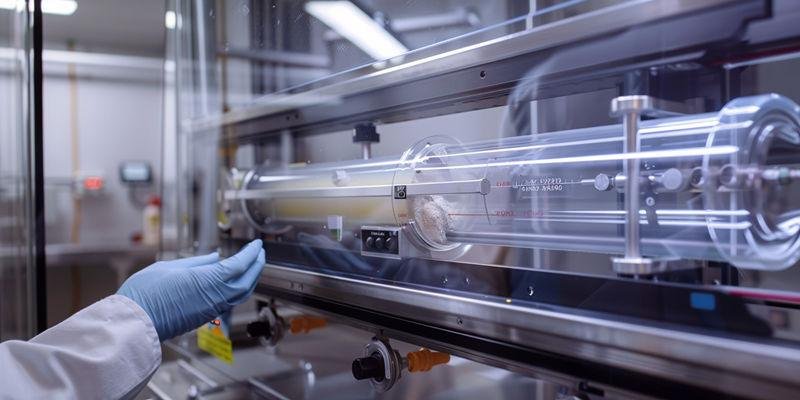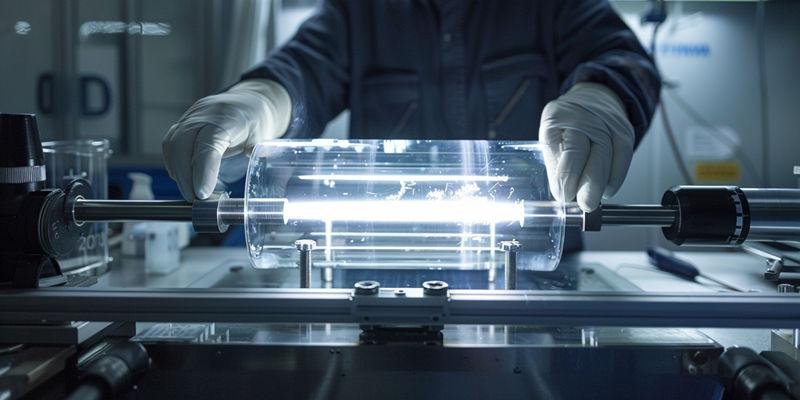Quartz glass is a critical material in photovoltaic (PV) manufacturing, but choosing the right grade and application method can be challenging.
To optimize PV production, engineers must understand quartz glass properties, application scenarios, technical standards, and decision frameworks for selection and maintenance.

This guide provides a comprehensive, engineer-focused reference for selecting, applying, and maintaining quartz glass in PV manufacturing, covering technical requirements, real-world cases, and future trends.
What Are the Inherent Properties and Industry Grades of Quartz Glass?
Quartz glass is prized in photovoltaic manufacturing for its exceptional purity, thermal stability, and chemical resistance.
These properties are critical for processes like crystal growth, diffusion, and etching, where contamination or deformation can lead to significant yield loss.
Industry standards classify quartz glass into different grades based on SiO₂ purity, metallic impurity content, and surface finish.
The main grades are semiconductor, solar, and general/industrial, each tailored to specific technical and economic requirements.

Understanding these grades helps engineers and buyers select the right material for each PV application. Choosing the correct grade ensures process compatibility, cost-effectiveness, and long-term reliability.
Quartz Glass Grades and Typical Parameters for Photovoltaic Applications
| Grade | SiO₂ Purity (%) | Metallic Impurities (ppm) | Surface Roughness (μm) | Typical Application |
|---|---|---|---|---|
| Semiconductor Grade | ≥99.999 | <0.1 | <0.2 | CZ crucibles, wafer carriers |
| Solar Grade | ≥99.995 | <1 | <0.5 | Solar crucibles, tubes |
| General/Industrial | ≥99.9 | <5 | <1.0 | Labware, general furnace parts |
Notes:
- Semiconductor Grade: Ultra-high purity and minimal metallic impurities, with extremely smooth surfaces. Used for applications highly sensitive to contamination, such as silicon crystal growth for semiconductors.
- Solar Grade: High purity and low metallic impurities, suitable for solar silicon wafer production and balancing performance with cost.
- General/Industrial Grade: Slightly lower purity and higher impurity tolerance, ideal for laboratory and general industrial uses.
How Is Quartz Glass Used in Key Photovoltaic Manufacturing Processes?
Quartz glass is integrated into multiple PV manufacturing steps, each with unique technical demands.
From crystal growth to cleaning and encapsulation, application-specific design and material selection are crucial.

Quartz Glass Applications in PV Manufacturing
| Process Step | Quartz Glass Component | Key Requirements |
|---|---|---|
| Crystal Growth | Crucibles, liners | High purity, thermal shock |
| Diffusion/Oxidation | Tubes, boats, furnace parts | Dimensional stability |
| Etching | Plates, carriers | Chemical resistance |
| Cleaning/Sealing | Custom parts, covers | Surface finish, compatibility |
Crucible Applications in Crystal Growth
Quartz crucibles are used for silicon ingot pulling (Czochralski process). They must withstand high temperatures, resist contamination, and maintain dimensional integrity throughout multiple cycles.
Diffusion and Oxidation Furnace Components
Quartz tubes and Quartz boatsare essential for high-temperature diffusion and oxidation. Their low thermal expansion and high purity prevent wafer contamination and ensure process consistency.
Etching Step Performance and Optimization
Quartz carriers and plates are exposed to aggressive chemicals during etching. Optimizing surface roughness and geometry reduces particle adhesion and improves yield.
Innovative Uses in Cleaning and Encapsulation
Custom quartz parts are increasingly used in advanced cleaning and encapsulation steps, where chemical compatibility and surface quality are critical for module reliability.
What Are the Technical Specifications and Core Performance Requirements for PV Quartz Glass?
Meeting international standards and technical benchmarks is non-negotiable for PV manufacturers.
Engineers must specify purity, thermal properties, and geometric tolerances to ensure process compatibility and product quality.
PV Quartz Glass Technical Specifications
| Specification | Typical Value/Standard | Test Method/Protocol |
|---|---|---|
| SiO₂ Purity (%) | ≥99.995 (solar), ≥99.999 (semi) | ICP-OES, ASTM E1479 |
| Thermal Shock (°C) | >200 (ΔT) | ISO 7884-7 |
| Surface Roughness | <0.5 μm | Profilometry, ISO 4287 |
| Dimensional Tolerance | ±0.2–0.5 mm | Caliper, CMM |
Purity Standards and International Testing Protocols
Quartz glass used in photovoltaic manufacturing1 must meet strict purity standards. The typical requirement is SiO₂ content of at least 99.995%.
International standards such as ASTM E1479 and ISO 9001 are commonly referenced. Purity is verified using methods like ICP-OES and GDMS2.
Regular third-party testing ensures compliance and traceability. High purity reduces contamination risk and improves cell efficiency.
Thermal Stability and Shock Resistance
Thermal stability is essential for quartz glass in high-temperature PV processes. The material must withstand continuous use at 1,050–1,200°C without deformation.
Thermal shock resistance is measured by the maximum temperature change (ΔT) the glass can endure, usually above 200°C. ISO 7884-73 is the standard for testing these properties.
Good thermal performance prevents cracking and extends component life. Always confirm these specs with your supplier.
Surface Roughness and Geometric Precision
Surface roughness affects contamination and cleaning efficiency.
For PV applications, quartz glass should have a surface roughness below 0.5 μm. Geometric precision is also critical, with tolerances typically within ±0.2–0.5 mm.
These parameters are measured using profilometry4 and coordinate measuring machines (CMM)5. Meeting these requirements ensures proper fit and process consistency. High precision reduces defects and improves overall yield.
How Can Engineers Use a Decision Framework to Select Quartz Glass for PV Applications?
A structured decision framework helps engineers balance performance, cost, and supplier reliability.
Consider key parameters, cost-benefit analysis, and supplier evaluation to minimize risk and maximize ROI.
Quartz Glass Selection Matrix for PV Applications
| Parameter | High Priority Use Case | Trade-Off Considerations |
|---|---|---|
| Purity Level | Crystal growth, diffusion | Higher cost for ultra-pure |
| Thermal Stability | All high-temp processes | May require custom design |
| Surface Finish | Etching, cleaning | Polishing increases cost |
| Supplier Certification | All | ISO, ASTM, audit required |
Key Performance Parameter Selection Matrix
Engineers should identify the most important performance parameters for each PV process. Purity, thermal stability, and surface finish are usually top priorities.
Use a matrix to compare available quartz glass grades against these requirements. Assign weight to each parameter based on process sensitivity. This approach helps ensure the selected material matches both technical and operational needs. Review and update the matrix as process demands evolve.
Cost-Benefit Analysis and Supplier Evaluation
Cost-benefit analysis goes beyond initial purchase price. Consider the total cost of ownership, including lifespan, maintenance, and potential downtime.
Evaluate suppliers for certifications, technical support, and delivery reliability. Request third-party test reports and customer references. Compare multiple suppliers to identify the best value for your project. A thorough evaluation reduces risk and supports long-term success.
Best Practices for Failure Diagnosis and Maintenance
Regular inspection is essential to detect early signs of wear or contamination. Use visual checks, surface testing, and documentation to track component condition.
When failures occur, analyze root causes such as thermal shock or chemical attack. Implement preventive maintenance schedules to extend service life. Keep detailed records of all maintenance and repairs. Proactive management minimizes downtime and improves process reliability.
What Are the Common Challenges and Future Optimization Strategies for PV Quartz Glass?
PV quartz glass users face challenges in contamination control, cost management, and adapting to new process requirements.
Future optimization focuses on advanced coatings, recycling, and digital monitoring.
PV Quartz Glass Challenges and Solutions
| Challenge | Impact | Optimization Strategy |
|---|---|---|
| Contamination | Yield loss, wafer defects | Advanced cleaning, coatings |
| Cost Pressure | Margin erosion | Supplier negotiation, recycling |
| Process Evolution | New specs, rapid change | Modular design, digital QA |
Continuous improvement and proactive supplier collaboration are key to staying ahead in the fast-evolving PV industry.
Conclusion
Quartz glass selection and application are central to PV manufacturing success. Engineers must align technical requirements, supplier quality, and process optimization for best results.
Navigating the complexities of PV quartz glass selection is a strategic challenge. Leverage TOQUARTZ’s engineering expertise, direct factory supply, and rapid delivery to ensure your photovoltaic project achieves world-class performance—contact us for tailored solutions and technical support.
FAQ (Frequently Asked Questions)
What purity level of quartz glass is required for silicon crystal growth in PV manufacturing?
A minimum of 99.995% SiO₂ purity is recommended for crystal growth crucibles to prevent contamination and ensure high yield.
How should buyers evaluate quartz glass suppliers for PV applications?
Check for ISO/ASTM certifications, third-party test reports, technical support capabilities, and proven track record in the PV industry.
What maintenance practices extend the lifespan of quartz glass components in PV lines?
Regular inspection, contamination testing, and preventive maintenance—such as scheduled cleaning and surface checks—are essential.
How does quartz glass compare to alternative materials in PV manufacturing?
Quartz glass offers unmatched purity, thermal stability, and chemical resistance compared to ceramics or metals, making it the preferred choice for critical PV processes.
References:
Learn how quartz glass plays a crucial role in photovoltaic manufacturing and why its purity directly impacts solar cell efficiency. ↩
Learn how GDMS (Glow Discharge Mass Spectrometry) ensures the highest purity in quartz glass, crucial for efficient and reliable solar cell production. ↩
Exploring the ISO 7884-7 standard will provide insights into testing methods for thermal properties of materials. ↩
Understanding profilometry can enhance your knowledge of precision measurement techniques crucial for quality control. ↩
Exploring CMM technology will provide insights into advanced measurement solutions that ensure product accuracy. ↩





